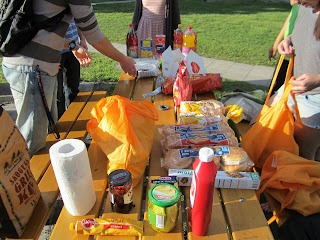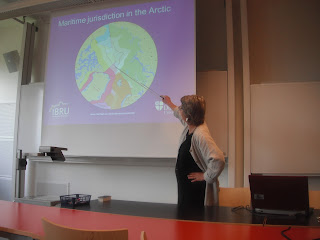 With a sun that rises around 3:30 a.m. it is a
necessity to keep our thick curtains shut or else sleep is difficult
to come by. The wailing of an IKEA alarm clock marks the start of a
new day. Any lingering “Z”s or feelings of exhaustion are easily
washed away with a hot and welcomed shower. Depending on the time
remaining before our daily group meet-up, a nice breakfast and time
to review lecture material tends to be a common and very beneficial
ritual. Breakfast typically consists of us being spoiled by the
various fresh and decadent breads and pastries that we have available
daily. Various jams and juices only sweeten the day’s first and
already delicious meal.
With a sun that rises around 3:30 a.m. it is a
necessity to keep our thick curtains shut or else sleep is difficult
to come by. The wailing of an IKEA alarm clock marks the start of a
new day. Any lingering “Z”s or feelings of exhaustion are easily
washed away with a hot and welcomed shower. Depending on the time
remaining before our daily group meet-up, a nice breakfast and time
to review lecture material tends to be a common and very beneficial
ritual. Breakfast typically consists of us being spoiled by the
various fresh and decadent breads and pastries that we have available
daily. Various jams and juices only sweeten the day’s first and
already delicious meal.
After a short walk and an even shorter trip on Stockholm’s Tunnelbana (subway) we find ourselves sitting in the classroom waiting for the start of lectures, which varies in subject from Arctic markets and geopolitics to historic Arctic explorations endeavors and even Nordic folklore and Romanticism themes that lie within this vast and unknown entity that was and still is the great Northern Arctic. Next in succession is our daily break, known as “Fika,” which is traditionally time for coffee or tea and pastries. Nearby cafes provide the perfect setting for enjoying a wide variety of coffees, teas, and pastries during a welcomed reprieve consisting of catching up on the daily happenings, discussing the day’s lecture material, and reminiscing about home. The end of break time signals the continuation of lecture and some discussion of thoughts on the key points.
Class is over, now what? Students may head into the city for a grocery store run and shopping trips are also commonplace. Heading back to campus housing for a nice little snack or maybe for a nap which often ends up being much longer than intended is always tempting but some students dive right into the next day’s coursework while others take an hour or so to just relax and simply enjoy being in Sweden. If you spend an evening with us, you may take part in a game of mafia around a campfire, watch a Euro 2012 match at the sports bar while enjoying a delicious kabob, or swim in the freezing nearby lake as the sun slowly dips under the horizon. Each day brings new lessons and mind-broadening concepts while each night brings new adventures, tales, and fond memories. Godnatt.
Rachel Bonet is a senior studying Anthropology, Animal Sciences, and Environmental Sciences at the University of Illinois at Urbana-Champaign. She intends to study Environmental Law. Rachel comes from Darien, IL.
Matthew Borden is a senior studying Natural Resources and Environmental Sciences at the University of Illinois at Urbana-Champaign, concentrating in Human Dimensions of the Environment. Matt hails from Oak
Forest, IL.


































